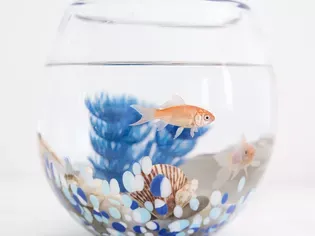How to Clean a Fishbowl
Updated on 04/26/24

The Ultimate Guide to Maintaining a Crystal-Clear Fishbowl: A Step-by-Step Journey to Spotless Aquatic Serenity
Welcome to the definitive guide on how to meticulously clean your fishbowl, ensuring a pristine environment for your beloved aquatic companions. From the initial preparations to the final touches, this comprehensive article will empower you with the knowledge and techniques to keep your fishbowl sparkling clean and your fish thriving.
Chapter 1: Gathering Your Essential Cleaning Arsenal
1. Bucket: A large bucket with ample capacity to hold the fishbowl's water.
2. Gravel Cleaner: A vacuum-like device designed to remove debris and waste from the substrate.
3. Algae Scraper: A tool with a sharp blade to remove algae buildup from the glass.
4. Soft Sponge or Cloth: For gentle cleaning of decorations and surfaces.
5. Dechlorinator: A water treatment solution to remove chlorine and chloramines from tap water.
6. Water Conditioner: A solution that neutralizes heavy metals and balances pH levels.
7. Bacteria Starter: A solution containing beneficial bacteria to help establish a healthy ecosystem.
Chapter 2: Preparing Your Fish for the Cleaning Process
1. Net and Bowl: Use a net to gently transfer your fish to a temporary holding bowl filled with a combination of clean water and water from the fishbowl.
2. Feeding: Avoid feeding your fish 24 hours prior to cleaning to minimize waste production.
3. Remove Decorations: Temporarily remove any decorations, plants, or artificial substrate to thoroughly clean them separately.
4. Turn Off Equipment: Shut off filters, heaters, and air pumps before starting the cleaning process.
Chapter 3: The Step-by-Step Cleaning Method
1. Empty Half the Water: Carefully pour out approximately half of the water from the fishbowl into the bucket.
2. Vacuum the Substrate: Use the gravel cleaner to thoroughly remove debris and waste from the substrate, being careful not to disturb the roots of live plants.
3. Clean the Glass: Use the algae scraper to gently scrape away algae buildup from the glass surfaces. Avoid using harsh chemicals or sharp objects that could damage the glass.
4. Wipe Down Decorations: Scrub the decorations and plants with a soft sponge or cloth to remove algae, debris, and waste. Rinse thoroughly with clean water.
5. Replace Water: Fill the fishbowl with approximately half of the clean water from the bucket.
6. Treat Water: Add the dechlorinator and water conditioner to neutralize harmful chemicals and balance the water chemistry.
7. Reassemble the Fishbowl: Place the decorations, plants, and substrate back into the fishbowl, ensuring they are properly arranged.
8. Add Fish: Gently net your fish and release them back into the cleaned fishbowl.
9. Add Bacteria Starter: If desired, add bacteria starter to help establish a healthy ecosystem in the fishbowl.
10. Top Off Water: Fill the fishbowl with the remaining clean water from the bucket.
11. Restart Equipment: Turn on the filter, heater, and air pump to restore the circulation and oxygenation of the water.
Chapter 4: Additional Tips for Maintaining a Clean Fishbowl
1. Regular Partial Water Changes: Perform weekly water changes to remove waste and prevent the buildup of toxins.
2. Monitor Water Parameters: Use test kits to regularly check the water quality for pH, ammonia, nitrite, and nitrate levels.
3. Clean Filter Media Regularly: Rinse or replace filter media as per the manufacturer's instructions to ensure optimal filtration.
4. Avoid Overfeeding: Stick to a regular feeding schedule and avoid overfeeding to minimize waste production.
5. Add Live Plants: Live plants help remove nitrates and provide a natural filtration system.
6. Quarantine New Fish: Before introducing new fish to your tank, quarantine them separately to prevent the introduction of diseases.
7. Use a UV Sterilizer: A UV sterilizer can help kill harmful bacteria and microorganisms in the water.
Chapter 5: Conclusion: The Rewards of a Spotless Fishbowl
Maintaining a clean fishbowl is not only essential for the well-being of your aquatic pets but also a rewarding experience that enhances the beauty of your home. By following the steps outlined in this guide, you can create a sparkling sanctuary for your fish, ensuring their health and happiness for years to come. Remember, a well-maintained fishbowl is not just a glimpse into an underwater world but a testament to your dedication and love for your aquatic companions.
Explore More Pets

Freshwater Aquarium Filters
How to Deal With Cloudy Aquarium Water

Saltwater Aquarium Filters
How Do You Remove Chloramines From Tap Water?

Freshwater Aquariums & Habitat
Can I Keep My Koi Fish Inside?

Saltwater Aquariums & Habitat
14 Best Floating Plants for Your Aquarium

Freshwater Fish Health
How to Treat Ich on Freshwater Fish

Saltwater Fish Health
Fin Rot in Aquarium Fish

Freshwater Aquarium Filters
How to Do Aquarium Water Changes

Saltwater Fish Health
How Do Fish Get Parasites?